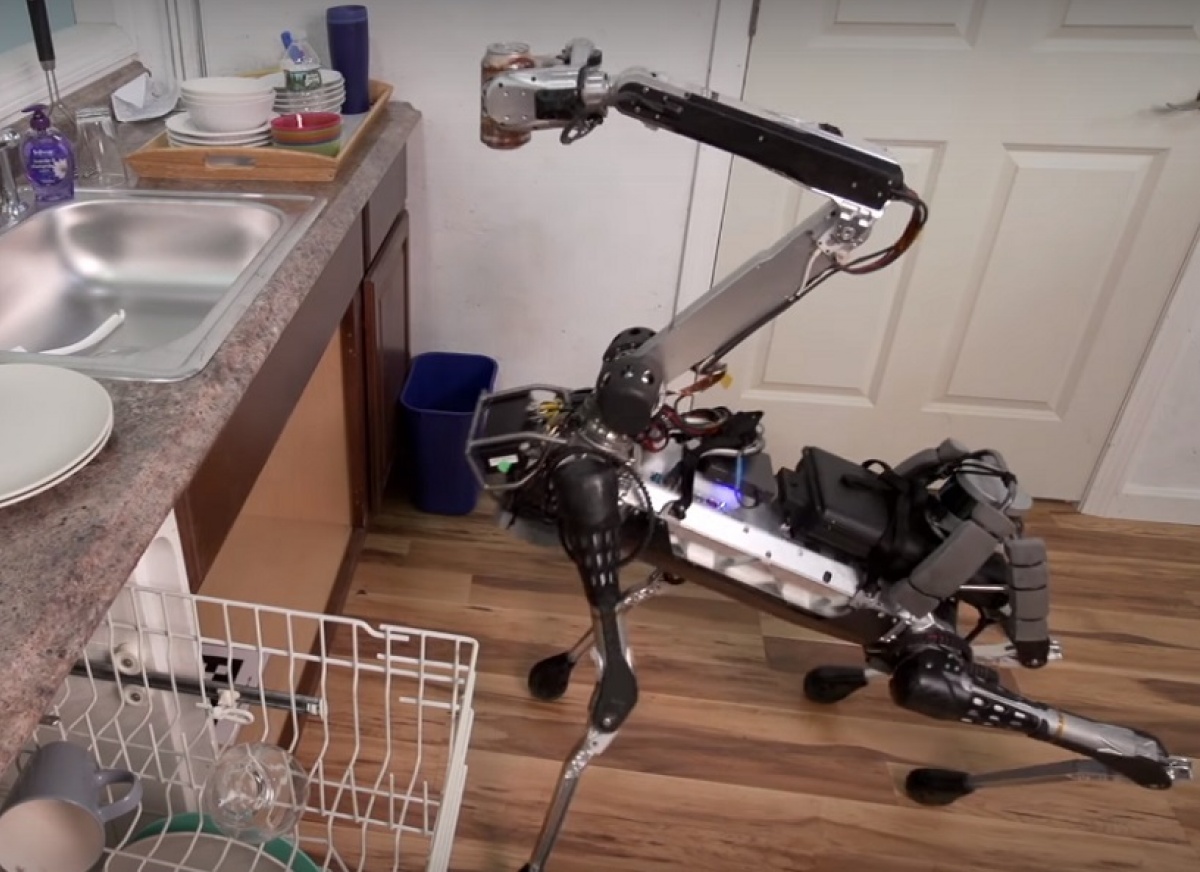Boston Dynamics suggests using SpotMini to deliver your robot.

Delivery of goods and mailings to home is a service that large telecommunication companies are now trying to automate. In particular, all this is proposed to be delivered using drones - similar projects are engaged in Amazon, Google and other companies. The division of the latter, Boston Dynamics, recently held a demonstration of the capabilities of its robot called SpotMini. This robot, according to its developers, can independently deliver parcels and small loads - but only for short distances.
The device, like many other developments of Boston Dynamics, has four “legs” with which the robot is simply masterfully controlled. The robot is equal in size to a large dog, so it does not take up too much space. Its weight is 25 kilograms, 30 - with a manipulator. SpotMini can go up and down stairs, open doors and even pick up laundry from a washing machine after the machine has washed everything. He knows how to put the dishes in the dishwasher. True, all tasks SpotMini performs only under the control of the operator.
For most operations, the robot uses a manipulator attached to its “neck.” Of course, SpotMini will not cope with too complex tasks, but it is quite able to carry out the simplest tasks of its owner. The robot has only partially automated it - it can show a little autonomy, but in most cases it is controlled by a human. Nevertheless, he can navigate in space, identifying obstacles and planning for himself the most convenient way in the room. Having received the command, he was able to take a can of drink from the table while demonstrating his capabilities.
The robot is almost not afraid of falls. Stepping on a banana peel and “feeling” the inevitable fall, the robot groups, and it does so fairly quickly. After that, the fall passes without problems.
In some cases, a robot of this type is quitecan replace wheel systems. This is especially true of the terrain with difficult terrain, where the wheels are not suitable for movement. The development of such devices is expensive, in some cases, the creation of a robot costs $ 1 million or more.
SpotMini can takefrom the countertop (or kitchen sink) dirty dishes and put it in the dishwasher. A robot can be played, as dogs usually do. The system is equipped with several sensors and sensors, including a depth camera, a gyroscope, and proprioception sensors (in this case, the sensor of contact with objects). The manipulator-neck is also equipped with a gyroscope, thanks to which the robot can keep the “head” at the same level, regardless of body movements. This behavior is typical for birds, including chickens. If the body of the chicken is held in the hands, moving in different directions, the head will be held at one point. The “eyes” were set so that the robot looked friendly.
Representatives of Boston Dynamics say that robots can be used not only in industry but also in everyday life. To this end, the Google division is developing a variety of robots. Spot Mini has already demonstrated the ability to open heavy doors with fancy-shaped handles. It was also tested by the company as a parcel delivery vehicle. In particular, the Spot Mini delivered several cargoes to residents of Boston homes. “Many are talking about shipping with drones. But why not use a robot with legs-manipulators? ”, Says Mark Reibert, CEO of Boston Dynamics.
Interestingly, at the moment, the division of Google, headed by Reibert, does not use machine learning. But in the future, as Reibert says, the situation may change, and the company will start working with a weak form of artificial intelligence.
As for the future, Reibert hinted at what the company is going to do in the near future. In particular, it will facilitate its systems, make them more energy efficient and versatile. Developers are already engaged in new versions of Spot and Atlas.
This company initially worked on the concept of a robot that could be useful to the military. In particular, there was a development of a robot that can be used by the military (for example, to carry ammunition).
Boston Dynamics was acquired by Google in 2013. After the takeover of the company, its new owner, Google, did not interfere with the work of the company's employees under current contracts with DARPA. But Google management decided to use the capabilities of Boston Dynamics to release robots for the consumer market. Perhaps SpotMini is just the “home” system that will be possible to use in everyday life soon.
Not so long ago, Google canceled plans to launch sales of self-taught robotic manipulators. As it turned out, robots of this type did not pass the “toothbrush test”. Here, the positive thing is that Alphabet has not completely abandoned its project, it works, although robots are not sold.
The very principle of the “toothbrush” as applied to company policy is: “Google should only produce systems that can use hundreds of millions or billions of people.” The decision to put such a principle into practice was taken at the end of 2015. It is not yet clear whether Google will make Boston Dynamics products mass or whether it is a more specialized project.
